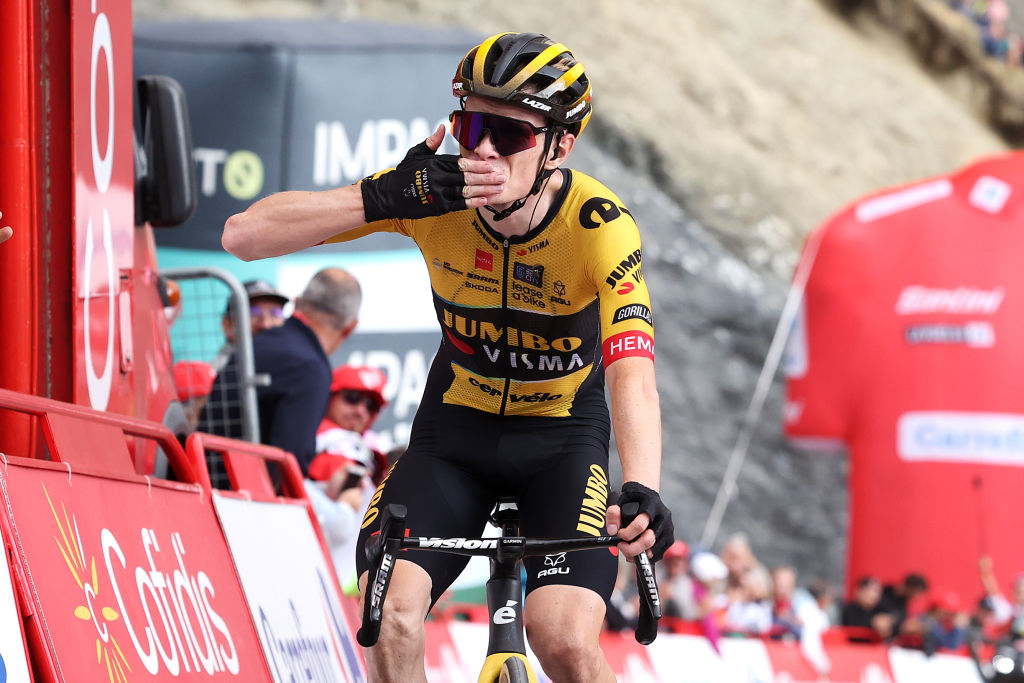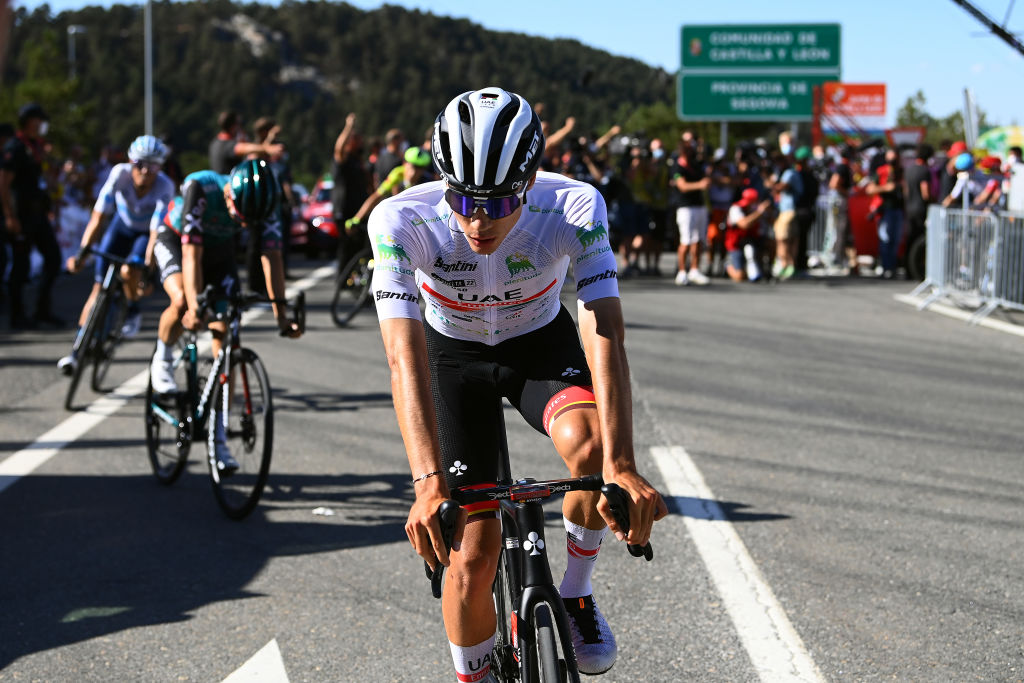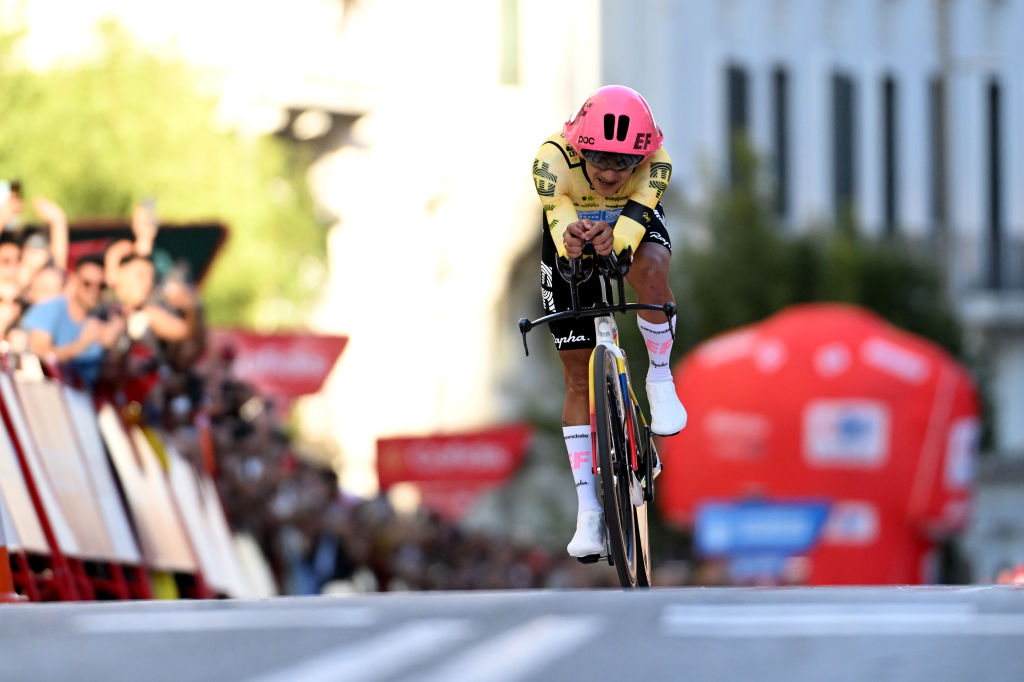Ever since Tadej Pogačar won the Tour de France, his subsequent decision to turn down the chance to go for his fourth Grand Tour victory in two seasons and tackle the Vuelta a España has logically dominated a lot of the summer cycling headlines.
However, the most notable development year-on-year in the 2025 Vuelta is not Pogačar’s absence. Rather, it’s that another Slovenian star, present every year in the Vuelta since 2019, winning four of them and taking third in another, will this time be missing from the Vuelta’s Turin start on Saturday, August 23.
Albeit in a much less high-profile Grand Tour, the power vacuum left by Primož Roglič (Red Bull-Bora-Hansgrohe) is still almost as important as if, for example, Pogačar were to announce he wasn’t doing the Tour de France one year.
You may like
It’s not only that Roglič’s current Vuelta victory tally is an equal all-time best with Spain’s Roberto Heras. In fact, there’s a strong argument to be made that he is the greatest all-time GC Vuelta rider, given that to date he has five more stage wins – 15 to 10 – than Heras and globally has spent six more days in the leader’s jersey as well. That’s even before we get to the question of Heras only being definitively confirmed the winner of the 2005 Vuelta after a lengthy court battle, too.
Yet, after doing both Giro and Tour, it was all but a given that, for the first time since 2020, the tried-and-tested narrative of Roglič’s Vuelta comebacks after a Tour de France disaster or major setback would be lacking this year.
Even in the 2024 Vuelta, where both he and Red Bull played down his chances of success following his battle against Tour de France injuries and a near last-minute addition to the line-up, it says a lot about Roglič’s status in the Vuelta that he remained the number one favourite all the same. And three weeks later, when he claimed his fourth title in Madrid, he’d definitely done more than enough to justify it.
Yet in all the fuss about Pogačar’s absence, it’s almost gone unnoticed that Roglič is just one of many familiar pieces in the usual Vuelta jigsaw to be out of action this August.
Enric Mas, Movistar’s four-time podium finisher in 2018, 2021, 2022 and 2024, has had to miss out on his home Grand Tour, too, because of thrombophlebitis. Albeit for a range of different reasons, others not present in Spain this year include the 2016, 2018 and 2023 winners, Nairo Quintana, Simon Yates and Remco Evenepoel. So two three of last year’s top podium finishers – Roglič and Mas – are missing, meaning the contrast with the Tour de France, with the same two faces atop the final podium in one order or another since 2021, could not be greater.
Vingegaard, Visma and the Vuelta

2023 Vuelta a España: Jonas Vingegaard wins on the Tourmalet (Image credit: Getty Images)
This dearth of past reference points, along with no Pogačar, means the Vuelta’s GC focus sharpens even more notably on what Jonas Vingegaard can achieve. Perhaps even if Roglič were present, the Visma-Lease a Bike leader’s run of four Tour de France podium positions, including victories in 2022 and 2023, would be enough in itself to place the 28-year-old Dane front and centre of the Vuelta favourites.
But by this late point in the season, motivation rather than just palmarès often constitutes a much more significant element of a rider’s potential to fight for the Vuelta.
It is important to remember that for Vingegaard, after his second straight defeat in July by Pogačar, the Vuelta represents an increasingly urgent and timely opportunity to re-establish his status as an alternative to the Slovenian champion. You could even say the Vuelta isn’t just a win Vingegaard wants for his trophy cabinet: it’s a win he needs.
It could also be argued that winning the Vuelta in itself would not be enough, now, for Vingegaard to reburnish his fading credentials as the leader of the Pogačar opposition. If he reaches Madrid with la roja in hand but only by a relatively small time margin, he will have simply cemented his status as ‘best of the rest’ behind the Slovenian. Just as Pogačar’s final attacks on the Montmartre stage of the Tour sent a message to his rivals about what awaits them in 2025, a more dominant mountain performance in the Vuelta would remind everybody that a Vingegaard in top condition still could give Pogačar a run for his money in the Tour.
On the plus side for Vingegaard, the Dane’s confidence will be bolstered both by the knowledge that in 2023, when he won his last Tour, he was able to follow that up in the Vuelta with a devastating display of climbing power on the Tourmalet and second overall in Madrid.
Like Roglič, without those team orders from Jumbo keeping Sepp Kuss as a leader despite the American being dropped by both his teammates on the Angliru, Vingegaard could maybe have won the race outright. That race, in any case, showed there can be no doubt that Vingegaard can perform at a top level in two Grand Tours in a single season, as he will do for the first time in two years in August.
Vingegaard will also be backed by a Visma line-up with more than enough firepower for a Tour de France, let alone the Vuelta. Giro d’Italia winner Simon Yates and the versatile Wout van Aert are not present like in July and like Van Aert was in the Vuelta last year, but both Matteo Jorgenson and 2023 Vuelta winner Sepp Kuss could form Plan Bs for GC should Vingegaard struggle or suffer a mishap.
Victor Campenaerts, who did sterling work for the Dane in July, has a well-known time trialling ability that makes him a central powerhouse both as a domestique and for the stage 5 team time trial. Wilco Kelderman’s colossal array of top Grand Tour mountain performances could make him yet another major climbing support rider for Vingegaard.
It’s also often forgotten that Visma are by far the most experienced team when it comes to winning Vueltas in recent years. Out of the last six, they have won four – three with Roglič and one with Kuss – and in a race that’s often as unpredictable and hard to read as the Vuelta, that store of experience in the team cars will likely be of great use when it comes to making tactical and strategic decisions.
The 2025 UAE-Visma Grand Tour duel, part three

Juan Ayuso during the 2022 Vuelta a España (Image credit: Getty Images)
If the absence of Pogačar and the power vacuum left by Roglič puts Vingegaard into pole position for victory, the collective strength in depth of UAE Team Emirates-XRG can never be underestimated. In fact, after the Giro and Tour, the Vuelta – on paper at least – looks set to be round three of the 2025 battle between the two top Grand Tour squads, with UAE teammates Juan Ayuso and João Almeida both keen to regain momentum after their respective abandons in May and July.
Ayuso in particular has a point to prove in the GC stakes, and not because Eddy Merckx recently claimed he didn’t have “the necessary strength” to rival Pogačar one day in a Grand Tour – the easy answer to that comment being ‘and who does?’.
Ayuso’s need for a strong Vuelta is born of other issues: after becoming the youngest ever Vuelta podium finisher when he took third in 2022 and then following that up with fourth in 2023, since 2024, his Grand Tour track record has been a real rollercoaster.
That began with his difficult 2024 Tour de France, when he was roundly berated by Almeida for apparently not working hard enough on the Galibier – something they later resolved – and then abandoned the race with Covid-19. Even before he quit in the third week of the 2025 Giro, despite an early stage win, the Spaniard’s race was already going askew when he was overshadowed in the overall battle by teammate Isaac del Toro.
Deemed surplus to UAE requirements in the 2025 Tour de France, Ayuso was only admitted to the UAE Vuelta line-up after Pogačar opted out. In a curiously similar situation to Vingegaard, assuming there are no outside factors like illness or crashes, Ayuso’s predicament is such that probably only a stand-out performance, rather than ‘just’ a good one, would now be enough to revalidate Ayuso’s Grand Tour credentials.
UAE, like Visma, will have a lineup worthy of the Tour de France, albeit with only two of their riders, Marc Soler and Almeida, present both in France and Spain this year in the Grand Tours. Fourth in the 2024 Tour, Almeida will not just be keen to put July behind him after a crash saw him abandon with injuries during the first week. He has unfinished business with the Vuelta after being forced out of the race with Covid-19 last September.
Should he or Ayuso shine, they have a lot of firepower to back them up in the UAE lineup: Jay Vine is a double Vuelta a España stage winner and 2024 King of the Mountains, Austrian Felix Großschartner is an experienced Grand Tour rider, and Ivo Oliveira and Mikkel Bjerg are all-rounder powerhouses. This gives yet more reasons for UAE to be the principal obstacle between Vingegaard and a first-ever victory for Denmark in the Vuelta come September 14 in Madrid.
The motivation factor

2024 Vuelta a España: Richard Carapaz on the final day of the race (Image credit: Getty Images)
Beyond UAE and Visma, Richard Carapaz (EF Education First-EasyPost) could well prove to be a formidable rival. He wore the leader’s jersey in his last Grand Tour visit to Turin in the 2024 Tour de France, has been on the final podium of all three Grand Tours, and won the Giro d’Italia. Carapaz has not raced since the Giro, making his form a mystery, but even so, he has to be included in the Vuelta’s usual long list of potential GC candidates.
In 2025, the list of outsider favourites ranges from former Giro d’Italia winners Egan Bernal (Ineos Grenadiers), and Jai Hindley (Red Bull-Bora-Hansgrohe) through to up-and-coming racers like Italian duo Giulio Pellizzari (Red Bull-Bora-Hansgrohe) and Antonio Tiberi (Bahrain Victorious), plus Ben O’Connor (Jayco AIUla) and Britain’s Tom Pidcock (Q36.5).
However, with a first major mountain challenge coming as soon as stage 6 into Andorra, if former Vueltas are anything to go by, a significant number of these candidates could suddenly disappear from the running for anything but stage wins after the opening leg into the Pyrenees.
For the leading favourites of UAE and Visma, riders like Carapaz are simply one of many uncertainties about the Vuelta that may or may not emerge as a major threat. Rather, the one key challenge that Ayuso, Vingegaard, and co. know they will face is the Vuelta’s ever-unpredictable, complicated route.
A route to challenge all, and favour Vingegaard
Starting in Italy for the first time in the Vuelta’s history will be a voyage in the dark for all the contenders, even if the roads of Piemonte, starting in the same Turin suburb of Venaria Reale as the Giro d’Italia in 2024, will be familiar. Things will get more uncertain once the Vuelta has made the long transfer back to Catalonia.
First week team time trials in Grand Tours are an increasing rarity; the last one was in Barcelona on a chaotic opening day of the 2023 Vuelta when a lack of street lighting left the race teetering on disaster. While the organisers have wisely not opted to repeat the experiment of running the team time trial in near-darkness, there is always a chance that at least one of the main contenders’ teams will fall apart on the rolling roads around Figueres close to the French frontier on stage 5’s TTT.
Then rather than repeat the format of 2024, where nearly all the big mountain stages were in the third week, this time the Vuelta keeps the favourites on their climbing toes throughout the race. Many of the 2025 Vuelta’s 11 summit finishes are not the typically short, steep climbs that tend to proliferate in the Vuelta, like the back-to-back Pyrenean stages to Pal and Cerler, the ascents to Valderazcay on stage 9, Belagua – where Evenepoel triumphed in 2023 – on stage 10, and Alto de El Morredero on stage 16.
Those are much more testing ascents where the differences between top riders could be measured out in minutes, not seconds. Furthermore, rather than place all the toughest high mountain stages – bar one – in the last week as in 2024, this year’s edition is constantly springing challenges on the riders with no fewer than three potential Queen stages.
These range from the well-known and massively daunting Angliru on stage 13, to the Farrapona on stage 14, where Vingegaard may be motivated by remembering one of his first top Grand Tour climbing performances in 2020 when he rode in support of Roglič. The last big stage goes to the Bola del Mundo, the Vuelta’s third-highest altitude finish at 2,251m above sea level on stage 20.
A time trial in Valladolid on stage 18 briefly places the ball back in the all-rounders’ court, but in fact this is a route made for the most able – and resistant – of climbers.
It’s ironic that what would have been the most ‘anti-Roglič’ of the Vuelta routes, given his love of snatching bonus seconds at summits rather than making long-distance attacks, is the one he’s not doing. Rather, with its visits to some of the Vuelta’s best-known mountains like the Angliru, it’s one which – assuming he’s in top condition – radically favours Vingegaard.
All the more reason then, to make the Danish star the standout pre-race favourite. However, part of the enduring appeal of the Vuelta is that, given this is the end of the season, motivation, rather than physical power, is arguably the key factor in the formula for success in Madrid. Roglič always had the setbacks of the Tour to boost him on in the Vuelta. Whether, after his second Tour defeat, that will prove enough for Vingegaard, will likely shape the whole outcome of the 2025 race.

Only one of these riders – O’Connor – has a chance of repeating his podium finish in Madrid this year (Image credit: Getty Images)
Subscribe to Cyclingnews for unlimited access to our 2025 Vuelta a España coverage. Our team of journalists are on the ground from the Italian Gran Partida through to Madrid, bringing you breaking news, analysis, and more, from every stage of the Grand Tour as it happens. Find out more.

